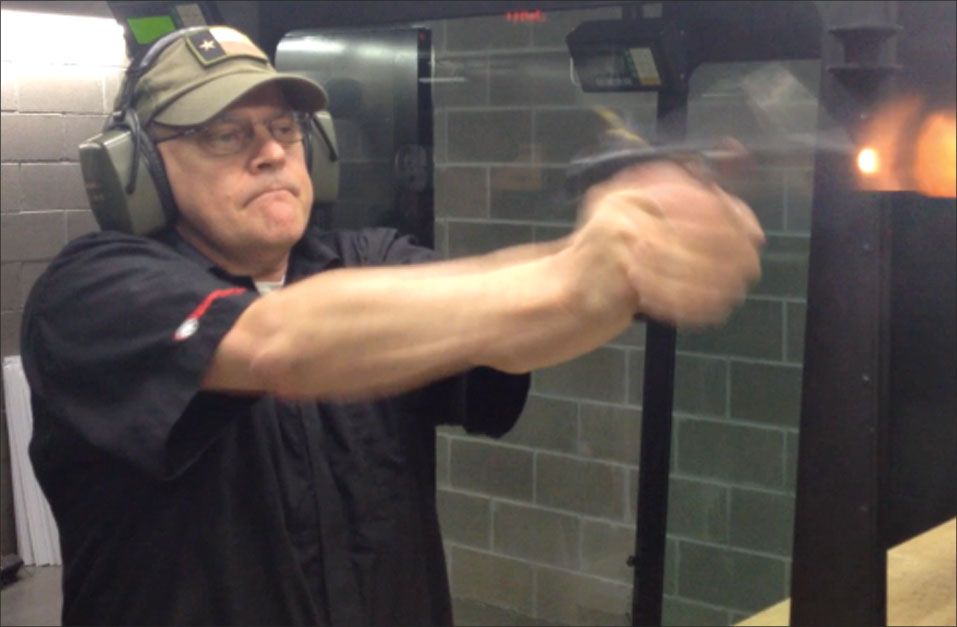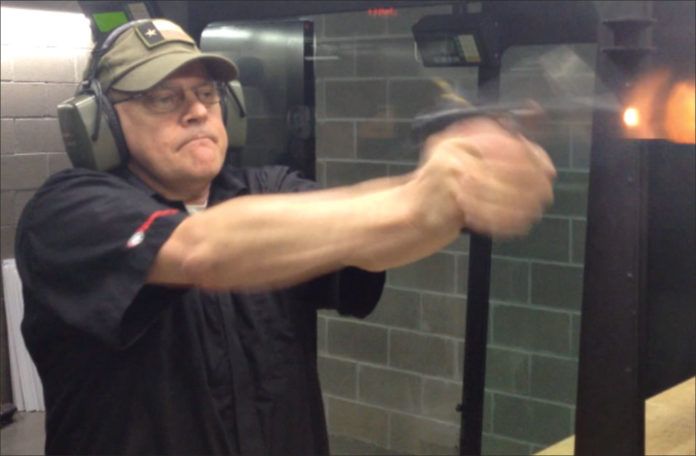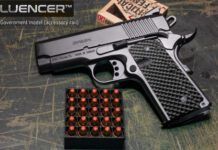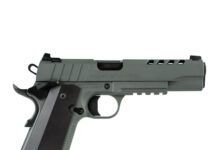If you have between $1500 and $2000 to put into a good 45 auto, which one will you get? There are many candidates, and choosing between them is often more a test of which brand name sounds the best — Wilson, Baer, Nighthawk, Guncrafter to name just a few — rather than which gun is the best for an individual shooter. Frankly, guns in this price range are very hard to separate because they’re all pretty darned good.

For this test, we looked at two names that aren’t top of mind, even though one of them has a historical provenance that is hard to match. The test guns were full-size 1911s in 45 ACP, one being the Ithaca Gun Co. M1911-N #1911-C45G10 45 ACP, $1799. Between 1942 and 1945, Ithaca Gun Company made 382,000 of the 45-caliber Model 1911-A1 pistols for the military, and according to company documents, Ithaca received a “certificate of appreciation” from the federal government for improving a manufacturing procedure for the triggers. The original Ithaca Gun Company was located in Ithaca, New York, and was probably best known for its M37 shotgun. When Ithaca restarted several years ago in Upper Sandusky, Ohio, new management invested in CNC machining to make its older guns cost-competitive with more modern designs. Those techniques were also applied to a very modern pistol product pitched as a semi-custom 1911 for carry or duty use. The Ithaca comes in a hard plastic case with foam inserts and a 1-year limited warranty.
Our second pistol was a Roberts Defense Super Grade Pro 45 ACP, $1549, made by the firm in Oshkosh, Wisconsin. Unlike Ithaca, which makes just two full-size pistol variants, Roberts makes six pistols in the Super Grade line alone (all $1549), including our full-size two-tone test gun, a full-size stainless model, two 4.25-inch barrel Custom models, and two of the firm’s Carry models with 3.5-inch barrels. The company’s Operator lineup includes four pistols (all $1649) and the Recon line has three versions (all $1499). Roberts Defense was founded in 2011, and the company says each firearm is hand-built using 100% American-made components. Each firearm comes in a tactical soft case with an accompanying gun lock. Impressively, Roberts Defense offers a lifetime transferable warranty.
Rob Unger, president of Roberts Defense said, “All of our parts are hand-fitted with the utmost attention to detail. We purposely build a limited amount of firearms to fit and function flawlessly, while never compromising, and making our high-quality product available at a reasonable price.”
We shot the guns for accuracy and function, and evaluated them for more than a year in self-defense training and general use. These were both outstanding pistols, yet we found some anomalies that might help you pick and choose.
Physical Comparison
Both 1911s are traditional single-action semi-autos that were very similar in size. The Ithaca’s dimensions were 8.75 inches in overall length, 5.6 inches in overall height, and a maximum width across the grips of 1.3 inches. The Roberts’ respective dimensions were 8.6, 5.9, and 1.3 inches. Unloaded, the Ithaca weighed 42.8 ounces and 47.4 ounces loaded, with a 7+1 payload, a round shorter than the Roberts, whose two blued Act-Mags held eight rounds apiece. The unloaded Roberts went 42.4 ounces and 47.6 ounces loaded. The Ithaca came with just one stainless-steel magazine. All the magazines came with detachable plastic bumpers to prevent them from getting damaged if dropped.
Both slide-lock safeties were left-side only, with the Roberts having a very large thumb shelf that we liked. Likewise, both had upswept extended beavertail grip safeties with big palm bumps for sure release. Both functioned as expected.
We wish both guns had beveling on the front edges to prevent holster wear. In particular, the leading edge of the RD was razor sharp, as were two points on the front of the magwell. The advantage of a stainless frame would be that the owner could knock all the edges off with a file and not have to reblue.
The front of both guns had well-fitted, thick barrel bushings. The Ithaca requires a supplied Allen-head wrench to break down. The Roberts required just a bushing wrench, but both were uneventful in field stripping and reassembly. Both slides had lowered and flared ejection ports, and the tool-steel hammers were skeletonized.
The Ithaca’s grips were made of checkered cocobolo with the “Ithaca” logo cut into the tops, whereas the RD’s were double-diamond-pattern VZ Grips’ laminate with a very aggressive texture. We preferred the slightly meatier and slightly less aggressive feel of the Ithaca.
Slides & Frames
Despite the physical similarities above, the guns’ slides and frames were very different. Both frames have standard 1911A1 cuts behind the trigger and flat mainspring housings. The Ithaca sported a flat-top matte-black carbon-steel upper with one set of rear grasping grooves; likewise, its matte-black frame was carbon steel, with the two pieces being hand-lapped for a tight fit. We could detect no looseness in the Ithaca’s fitting, yet its slide still moved smoothly under hand operation. That’s also true of the RD, whose black-nitride-finished satin-stainless-steel slide sported front and rear grip serrations on its grooved, rounded top. It, too, was tight as a drum, yet smooth, due to hand-fitting between the satin-stainless-steel frame and slide at the factory. Execution of metal checkering was nearly identical on the front straps. The slightly coarser 22-lpi pattern went from grip panel to grip panel on the Ithaca’s front strap, whereas the RD’s 25-lpi checkering didn’t quite wrap all the way around the front. When blind handling the pistols without gloves, we couldn’t tell much of a difference in the metal-checkering execution, but the grip panels were another matter. Both guns’ magwells were lightly beveled for better magazine insertion.
Sights
The Ithaca’s front sight was a grooved-face blade dovetailed into the slide with an Allen-head retention screw. Paired with an adjustable Novak-style rear, also dovetailed in but lacking a retention screw, we got a superb view of the target with great light bars. The Roberts sights were also quality units. The front sight was a Kensight contoured blade with a Trijicon H3 Tritium insert. It was paired with a Kensight DFS 1911 Tritium rear sight with a recessed blade, both dovetailed into the slide and further held with tiny screws.
During our range session, we made only a couple of clicks adjustment in the Ithaca’s rear sight to move up the groups about an inch. In contrast, the Roberts required drifting the rear sight to correct windage point of impact. Because the top of the Roberts slide was grooved, we could see the middle of the front sight lamp was five grooves from the left side of the frame. Using a pencil, we marked that groove in the slide all the way back to the rear sight and saw the retention screw in the middle of the rear sight was about two grooves off to the left.
To remember which way to drift the sight, the acronym FORDS (Front Opposite, Rear Direction Same) is helpful. To move the point of impact to the right, we loosened the set screw in the Kensight rear sight and used a 1-inch nylon/brass hammer (Brownells #818-600-100WB, $20) to tap the steel rear sight in the dovetail. The sight was loose enough in the dovetail that we didn’t need to use a brass punch and more effort. The Robert’s elevation POI at 25 yards was right on with the 230-grain rounds, so no adjustment was needed there.
We went round and round about which sight is better. Our shooters preferred the target performance of the Ithaca, but we recognized its sights would be next to useless in the dark without a flashlight on the target.
Range Data
We tested with three types of 45 ACP ammunition with different bullet profiles and bullet weights: Get On Target Ammunition, a 230-grain FMJ ball style; a PMC Bronze 185-grain jacketed hollowpoint; and a Speer Lawman 185-grain truncated metal jacket with a squarish nose profile. During the 250-round break-in period, the Roberts had initial failures to feed with the PMC ammo. In the first magazine we loaded, a round failed to strip off and leave the magazine. The second round in that first magazine failed to chamber. The third round didn’t go into battery. Using the same magazine with the Lawman rounds, the Roberts had one occurrence of a first round in the magazine failing to chamber. The second round in that first magazine required the shooter to push the slide closed to chamber. Rounds three through seven (it held eight) fed normally. The Roberts continued to have intermittent failures to chamber with the Lawman for the first 100 rounds of chrono and break in. But once we began offhand shooting, cycling improved.
Both guns featured 5.0-inch match-grade stainless-steel barrels, and with their tight fits and reasonable trigger-pull finishes (4.1 and 4.9 pounds for the Ithaca and RD, respectively), we expected and got pretty good accuracy overall, and in some cases, superb accuracy. Both triggers were skeletonized aluminum units and had overtravel adjustment screws.
Off the bench, the two pistols shot very well and produced similar velocities. The Get On Target 230-grain FMJ produced an average velocity of 766 fps in the Ithaca and 772 fps in the Roberts, with corresponding muzzle-energy calculations of 300 foot-pounds and 304 foot-pounds. With this round the Roberts outshot the Ithaca off the bench, with a 1.7-inch average group size compared to the Ithaca’s 2.4-inch average group size. Offhand, however, the Ithaca was better, 2.8 inches to 4.5 inches. Moreover, the Ithaca shot to windage point of aim at 25 yards out of the box, and just a little low.
The results were closer with the PMC Bronze 185-grain JHPs, with very little difference in average velocity (Ithaca, 935 fps; Roberts, 936 fps) and muzzle energy (359 foot-pounds and 360 foot-pounds, respectively). Bench groups were similar as well, with the Ithaca holding a slight edge, 2.2 to 2.5 inches. However, the Roberts put its groups about 2 inches high at 25 yards, which required a change in point of aim to correct, since there’s no easy elevation fix without replacing the front blade with a taller version (Front Opposite). Average offhand group sizes were close as well, 3.1 and 3.3 inches, respectively.
The Speer Lawman ran a little faster in the Ithaca, 1041 fps to 1037 fps, and produced nominally more energy, 445 foot-pounds to 442 foot-pounds. And despite its initial function problems, the Roberts beat the Ithaca off the bench with this round, 1.3 inches to 1.4 inches. Offhand, however, the Ithaca came out ahead, 2.4 inches to 3.0 inches.
The Market
We’ve tested a few pricey full-size 45s over the last ten years, so it’s worth recapping some of those evaluations before placing the current two guns in the mix.
The three contestants in a February 2010 match up were the Smith & Wesson Model MSW1911 No. 108284 ($1256, B+), their top end stock model; Springfield Armory’s TRP Light Rail Model ($1919, A-), a burly gun in basic black; and STI International’s ISPC- and USPCA-legal Sentinel Premier. The hard-chrome model came in at a wallet-draining $2413 and earned an A grade.
In the May 2009 issue, we covered the superb (A+) Michiguns 45 Commander Custom, about $5000, available from Ned Christiansen. If you want a gun from Michiguns, be prepared to wait five or six years. Christiansen’s innovative touches and incredible machining skills have vaulted him to the top echelon of gunsmiths, with a resultant huge backlog.
In the April 2009 issue, our test team shot and evaluated three high-end custom full-size 1911s: the Combat Custom, $2895, from Luke Volkmann of Volkmann Custom Inc.; Wilson’s CQB, $2550, and Les Baer’s Premier II Super-Tac, $2280. Attempting to pick the best one was anything but easy. They were all excellent. But we graded the Wilson CQB as the Our Pick of that trio.
In the November 2006 issue, we found some flaws in a Rock River Pro Carry, $1795, and gave it a Conditional Buy. We said Don’t Buy the Nighthawk GRP 45 ACP, $2695, because of its weight, sharp edges, atrocious rear sight picture, and too-sticky grips. The Wilson Combat CQB No. WCQB-T-A, $2150, was an Our Pick.
In the January 2005 issue, we gave Buy It ratings to both a Les Baer Ultimate Master, $2470, and a Les Baer Monolith Heavyweight, $2011. But we said the Les Baer Premier II, $1498, was a Best Buy for its tight fit, adjustable sights, great feed reliability, and more.
In the April 2004 issue, we said Don’t Buy the Kimber LTP II, $2036, because our unit was unreliable. We also passed on the Lone Star Lawman Match, $1595, for the same reason. We gave a Conditional Buy recommendation to the Wilson CQB, $1895, because its minor problems were easily rectified by the owner in just a few minutes.
Our Team Said
The Ithaca Gun Co. M1911-N #1911-C45G10 45 ACP, $1799, gets an A grade from us. It’s a tightly fitted, accurate, reliable, nice looking pistol.
The Roberts Defense Super Grade Pro 45 ACP, $1549, is likewise well made, and after a reasonable break in, perfectly reliable. Its rear sight offered better low-light performance than the Ithaca, but we’d prefer a fully adjustable rear (or an elevation-adjustable, driftable rear) to make changing ammunition a little easier. It had a couple of sharp spots that need dressing with a file, so after careful thought, it came in at an A- mark.
Written and photographed by Gun Tests staff, using evaluations from team testers.





























